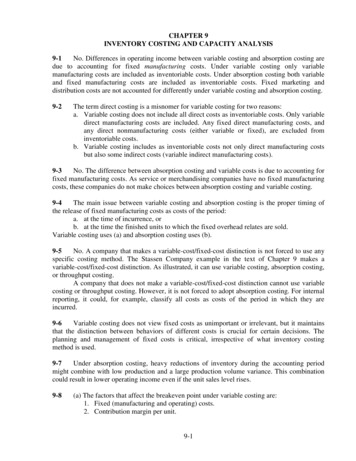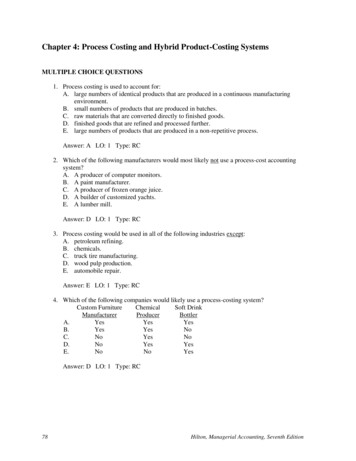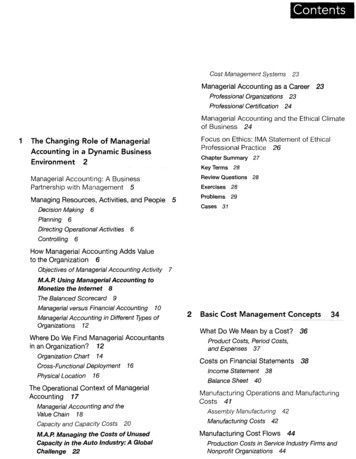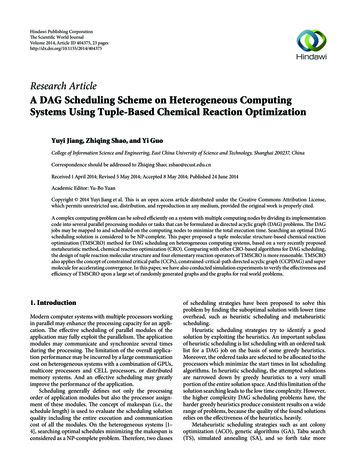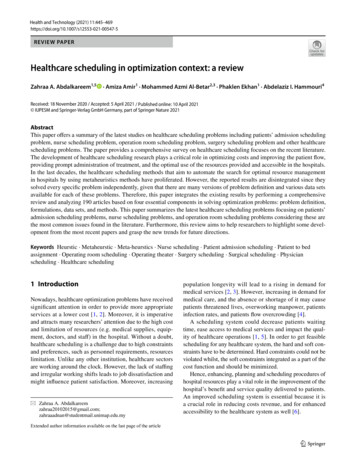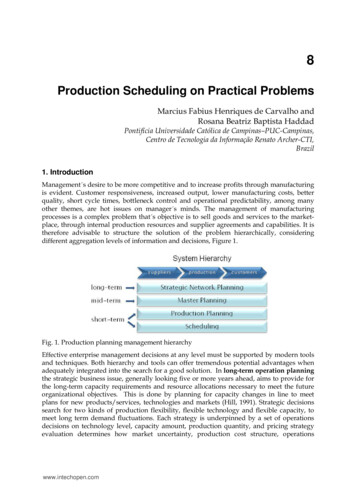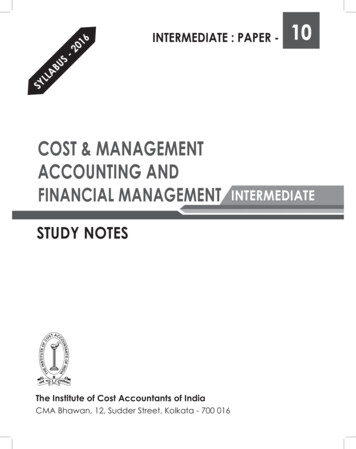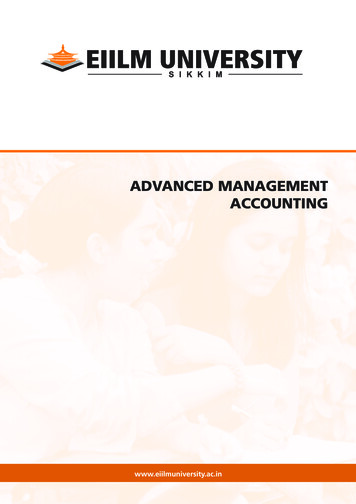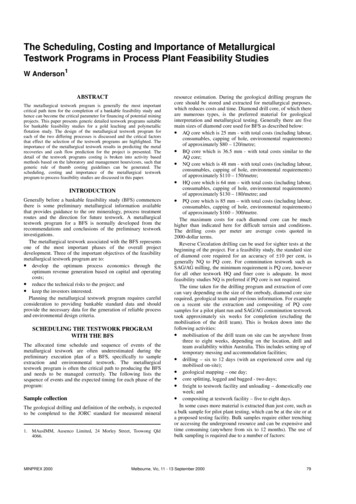
Transcription
The Scheduling, Costing and Importance of MetallurgicalTestwork Programs in Process Plant Feasibility StudiesW Anderson1ABSTRACTThe metallurgical testwork program is generally the most importantcritical path item for the completion of a bankable feasibility study andhence can become the critical parameter for financing of potential miningprojects. This paper presents generic detailed testwork programs suitablefor bankable feasibility studies for a gold leaching and polymetallicflotation study. The design of the metallurgical testwork program foreach of the two differing processes is discussed and the critical factorsthat effect the selection of the testwork programs are highlighted. Theimportance of the metallurgical testwork results in predicting the metalrecoveries and cash flow prediction for the project is presented. Thedetail of the testwork programs costing is broken into activity basedmethods based on the laboratory and management hours/costs, such thatgeneric rule of thumb costing guidelines can be generated. Thescheduling, costing and importance of the metallurgical testworkprogram to process feasibility studies are discussed in this paper.INTRODUCTIONGenerally before a bankable feasibility study (BFS) commencesthere is some preliminary metallurgical information availablethat provides guidance to the ore mineralogy, process treatmentroutes and the direction for future testwork. A metallurgicaltestwork program for a BFS is normally developed from therecommendations and conclusions of the preliminary testworkinvestigations.The metallurgical testwork associated with the BFS representsone of the most important phases of the overall projectdevelopment. Three of the important objectives of the feasibilitymetallurgical testwork program are to: develop the optimum process economics through theoptimum revenue generation based on capital and operatingcosts; reduce the technical risks to the project; and keep the investors interested.Planning the metallurgical testwork program requires carefulconsideration to providing bankable standard data and shouldprovide the necessary data for the generation of reliable processand environmental design criteria.SCHEDULING THE TESTWORK PROGRAMWITH THE BFSThe allocated time schedule and sequence of events of themetallurgical testwork are often underestimated during thepreliminary execution plan of a BFS, specifically to sampleextraction and environmental testwork. The metallurgicaltestwork program is often the critical path to producing the BFSand needs to be managed correctly. The following lists thesequence of events and the expected timing for each phase of theprogram:Sample collectionThe geological drilling and definition of the orebody, is expectedto be completed to the JORC standard for measured mineral1.MAusIMM, Ausenco Limited, 24 Morley Street, Toowong Qld4066.MINPREX 2000resource estimation. During the geological drilling program thecore should be stored and extracted for metallurgical purposes,which reduces costs and time. Diamond drill core, of which thereare numerous types, is the preferred material for geologicalinterpretation and metallurgical testing. Generally there are fivemain sizes of diamond core used for BFS as described below: AQ core which is 25 mm - with total costs (including labour,consumables, capping of hole, environmental requirements)of approximately 80 – 120/metre; BQ core which is 36.5 mm - with total costs similar to theAQ core; NQ core which is 48 mm - with total costs (including labour,consumables, capping of hole, environmental requirements)of approximately 110 – 150/metre; HQ core which is 64 mm – with total costs (including labour,consumables, capping of hole, environmental requirements)of approximately 130 – 180/metre; and PQ core which is 85 mm – with total costs (including labour,consumables, capping of hole, environmental requirements)of approximately 160 – 300/metre.The maximum costs for each diamond core can be muchhigher than indicated here for difficult terrain and conditions.The drilling costs per meter are average costs quoted in2000-dollar terms.Reverse Circulation drilling can be used for sighter tests at thebeginning of the project. For a feasibility study, the standard sizeof diamond core required for an accuracy of 10 per cent, isgenerally NQ to PQ core. For comminution testwork such asSAG/AG milling, the minimum requirement is PQ core, howeverfor all other testwork HQ and finer core is adequate. In mostfeasibility studies NQ is preferred if PQ core is not required.The time taken for the drilling program and extraction of corecan vary depending on the size of the orebody, diamond core sizerequired, geological team and previous information. For exampleon a recent site the extraction and compositing of PQ coresamples for a pilot plant run and SAG/AG comminution testworktook approximately six weeks for completion (excluding themobilisation of the drill team). This is broken down into thefollowing activities: mobilisation of the drill team on site can be anywhere fromthree to eight weeks, depending on the location, drill andteam availability within Australia. This includes setting up oftemporary messing and accommodation facilities; drilling – six to 12 days (with an experienced crew and rigmobilised on-site); geological mapping – one day; core splitting, logged and bagged - two days; freight to testwork facility and unloading – domestically oneweek; and compositing at testwork facility – five to eight days.In some cases more material is extracted than just core, such asa bulk sample for pilot plant testing, which can be at the site or ata proposed testing facility. Bulk samples require either trenchingor accessing the underground resource and can be expensive andtime consuming (anywhere from six to 12 months). The use ofbulk sampling is required due to a number of factors:Melbourne, Vic, 11 - 13 September 200079
W ANDERSON the mineralisation could be disseminated and a drilling program would not accurately predict the metallurgicalperformance;in some cases the ore is easily accessible and the sample canbe easily extracted. In some circumstances it may be cheaperthan a drilling program; andif an on-site pilot plant is required due to a new processtreatment route that is required, a bulk sample is required forfeeding the plant.Gold BFS Metallurgical testwork program scheduleThe process design criteria and mass balances form the basis ofthe engineering design of the process plant. The process designcriteria and mass balances are based on the metallurgicaltestwork. Hence the metallurgical testwork is normally thecritical path for a BFS.For a 1 to 1.5 Mtpa gold/flotation plant with a seven to tenyear life, the draft bankable feasibility study report would becompleted within six to eight months. A general estimate of thetime it takes to complete a feasibility study can be estimatedfrom the scheduled time of the metallurgical testwork. The draftBFS report is generally completed within six to eight weeks afterthe metallurgical testwork results are completed. The final BFSreport is then completed within two to three weeks after the draftreport has been issued. The reason why the BFS schedule isdependent on the metallurgical testwork results, is that theinformation from the metallurgical testwork program needs to beincluded into the design criteria. The design criteria forms thebasis by which the equipment for the plant is selected. The BFSschedule is then driven by the capital estimate, which isgenerated from enquiries sent out to vendors and the site layoutand elevation drawings. The procedure of the capital estimate,including the site layout drawings, takes between four to eightweeks.The design criteria can be concurrently developed with thetestwork and hence minimise the BFS schedule. However,completing a preliminary design criteria without testwork canlead to overruns in engineering costs. The grinding testwork datais generally completed at the beginning of the metallurgicaltestwork program, hence the crushing and grinding circuit can bedeveloped as the data becomes available. The site layout of thecrushing and grinding can also be completed, which aregenerally 30 to 40 per cent of the drafting required for a simplegold/flotation plant of 1 Mtpa. By managing the studyappropriately, the impact of the metallurgical testwork programon the BFS schedule can be reduced.Where a gold/flotation plant has further complexities with oretreatment or final product handling, these expected dates couldbe doubled. The timing also depends on the amount and degreeof complexity of the number of process options that have to beevaluated.A typical BFS schedule is shown in Appendix 1. The scheduleshows the starting point of the process plant engineering as thepreliminary metallurgical testwork results.In completing a BFS there are a number of functional areasthat are also addressed by specialised subconsultants such asgeology, mining, site geotechnical, mining and surfacehydrology, infrastructure, financial, legal/regulatory, marketing,tailings and environmental. Most of these subconsultants wouldhave started, by up to two months, their respective sections of thefeasibility study prior to the expected finish time of themetallurgical testwork program. In some cases some of thesubconsultants could have their respective sections 70 per centcomplete, before the metallurgical testwork progam is finished.The following testwork schedules are typical estimates basedon the specified tonnages:80 for 1.5 Mtpa plant, life of eight years, allow 20 to 24 weeks;sample collection six weeks;sample preparation two weeks;variable/economic grinding size/leach testwork three to sixweeks;SAG Amenability Testwork;- sample preparation of ore and waste one to two weeks;- testwork, eg Advance Media Competency (AMC) up tofour to six weeks;bulk testwork for leach, carbon adsorption four weeks;tailings characterisation for tailings dam four weeks; andtailings characterisation for environmental kinetic three tofive months.Flotation BFS for 1.5 Mtpa plant, life of eight years, allow 21 to 26 weeks;sample collection six weeks;sample preparation two weeks;mineralogy three weeks;variable/economic grinding size/ flotation testwork,including locked cycle eight to 12 weeks; pilot plant run for bulk tails and concentrate three weeks ofapproximately 150 to 300 kg/h for 12 hours; SAG Amenability Testwork;- sample preparation of ore and waste one to two weeks;- testwork, eg Advance Media Competency (AMC) up tofour to six weeks; tailings characterisation for tailings dam four weeks; tailings characterisation for environmental kinetic three tofive months; and concentrate filtration and thickening testwork two to threeweeks.An example of a typical gold metallurgical schedule for anuncomplicated orebody with two ore types, a laterite and anoxide type, is shown in Appendix 2.The important drivers to the metallurgical testwork scheduleand hence the BFS are:Gold BFS sample collection; initial tests for size/leach flowsheet optimisation; and tailings bulk sample for thickening, tailings dam andenvironmental testwork.Flotation BFS sample collection;head mineralogy/assay;initial tests for size/circuit flowsheet optimisation;concentrate bulk sample for filtration/thickening testwork;and tailings bulk sample for thickening, tailings dam andenvironmental testwork.There are a number of management actions that can be used toreduce the metallurgical testwork program and increase theaccuracy of the BFS. Three of these actions are presented below: The compositing of the metallurgical sample should becollated in close liaison with the geological, mining andmetallurgical consultants so that the sample represents themine production schedule, including the percentage of wasteMelbourne, Vic, 11 - 13 September 2000MINPREX 2000
THE SCHEDULING, COSTING AND IMPORTANCE OF METALLURGICAL TESTWORK PROGRAMSmaterial. The status of the mine production schedule is veryimportant. Using a preliminary mine plan that is likely tochange, as a basis for the composite sample preparation canlead to poor correlations between the mine and metallurgicaltestwork head grades or ore, which can reduce the accuracyof the BFS. Use of specialised consultants for some sections of thetestwork program, eg filtration and thickening. Factorial designed metallurgical testwork can significantlyreduce the timing of metallurgical testwork programs due toa number of factors:- reduce the amount of sample required per test;- reduce the amount of time per test;- statistically verify a circuit or reagent regime with ahigher level of confidence; and- simple to set up.The level of detail required for the metallurgical testworkprogram governs the BFS. Generally the data presented above isa good starting point for considering deadlines for the BFS andimportant points to consider with the schedule of themetallurgical testwork program.PLAN FOR THE METALLURGICAL TESTWORKPROGRAMPlanning of a metallurgical testwork program requires carefulconsideration of a number of factors to ensure that the dataproduced meets that required for a BFS. The metallurgicaltestwork should also generate sufficient information for theoptimisation of the process economics and reliable data to beused in the process plant design.The initial plan for the testwork will be most likely based onthe previous testwork. The following are points that should alsobe raised at this stage: what other orebodies of this type are globally mined? what is the process used for extraction? who are the experts in this field? can operations with similar process unit operations and oretypes be contacted to understand their experiences?In developing the metallurgical testwork program thefollowing should be considered: Geological and mineralogical features of the orebody.The mineralogical assessment of the orebody is an importantinitial phase and money invested correctly initially cansignificantly improve the process economics of the orebody.This is especially the case for flotation studies and the use ofdiagnostic leaching for gold. There are cases where the sameorebody has been proven uneconomical for some companiesand proven economical by others due to the mineralogicalinformation. This includes the assessment of the different oretypes, grain size of valuable mineral, association of valuablemineral to contaminants and liberation characteristics. Themineralogical program should be compiled to highlightdiffering ore types and be combined with the geologicalstructure of the ore horizon.The geological structures can provide hints to the behaviourof the ore types. For example a drilling program may findthat the ore was competent to drill in some sections and drillbits were worn frequently, giving an indication to thehardness/abrasiveness of certain ore zones. Major faults canprovide the basis for differing ore types and certaingeological zones can contain excessive states of oxidation,which highlights mine to mill planning issues during oreextraction. This can lead to a specific metallurgical testworkprogram that confirms these preliminary inferences.MINPREX 2000 Waste and dilution from mining The inclusion of an appropriate percentage of dilutionmaterial is important to the development of the physical andchemical testwork program. Particular types of wastematerial can have deleterious effects on the metallurgicalresponse of ore types, for example the content of a graphiticcomponent in a gold or flotation plant. The inclusion ofwaste should be representative of the mining plan, eg if thephysical testwork is carried out on 30 per cent dilution, yetthe mining plan has only 15 per cent dilution, then thetestwork can lead to an oversized comminution circuit.Alternatively the inclusion of waste into the program canindicate that from particular ore zones no more than X percent of the hanging or footwall can be delivered to theprocess plant. This can then set key performance indicatorsfor the project design for the mine as well as the processplant.The selection of the amount of waste/ore ratio that should beincluded in the sizing of the comminution circuit must becarefully scrutinised. Grinding circuits are generally thehighest power user and the highest capital cost item of theplant. In using a too high or low number for the waste/oreratio in sizing the grinding circuit can result in either anoversized or undersized grinding circuit.Composite samples should represent the orebody as mined.The number of composite samples selected should be basedon the number of different ore types and aim to represent themining production schedule. One of the important outcomesfrom the metallurgical testwork program is the predictedcash flow forecast based on the mining production schedule.Hence the metallurgical testwork must represent the expectedore feed grades from the mining schedule for an accurateperformance prediction of the metal grade and tonnageproduced. Different ore types affect the cash flow generatedfrom the project due to the metal tonnes produced and theoperating costs. Hence if different ore types react quitedifferently and are mined in different periods, the effect ofthis must be included in the financial model.The composite samples should represent the orebody asrelevant treatment periods, including any deleterious materialthat will be expected during the production period.Testwork schedule in reference to the BFS requirementThere are a number of key milestones that need to be met tofinish the BFS on time. This becomes very important if apresentation to the decision-makers is required at a set dateand the BFS schedule is aimed at this date. This sets thefocus on the testwork program output and can define theproject success.Selection of an appropriate laboratory facilityThere are a number of laboratory facilities with differingcapabilities and this can be important in optimising thetestwork program data. The criteria for laboratory selectionshould involve some of the following; delivery of reports, thequality control practices in use, experience with similar typesof material, examples of testwork programs being completedon schedule and budget, how often does the company reviewtestwork or brain storm ideas throughout a program. Alaboratory can be effective with a gold testwork program butnot so with flotation.Consideration for tailings disposalThis is an area that needs special consideration, dependingon the location of the project and the environmentalconsiderations. The timing of this type of testwork is also animportant factor due to the length of time required for theenvironmental and backfill testwork, if required. For anunderground operation the advantage of storing tailingsunderground can be very attractive and can improve theMelbourne, Vic, 11 - 13 September 200081
W ANDERSONmining production schedule and environmental factors. Thetestwork required for the potential of the sulphide flotationtailings to be acid producing and the detoxification of acyanide gold tail is very important and needs specialconsideration.The tailings treatment can add significant costs to the project,depending on the size, storage requirement, type of tailingsand environmental considerations and hence is an importantsection of any BFS metallurgical program. The curing timesfor the backfill strength determination can be in the order of30 to 60 days and this then becomes a critical path item forthe testwork program. Hence if backfill testwork is requiredthen a tailings sample may need to be produced as a priority.Example of a composite sample preparationOn a recent feasibility study, before commencing compositesample preparation, all the drill hole intercepts from the drillingprogram were listed and those for which samples were availablefor metallurgical testwork identified. The available interceptswere then reviewed to assess whether they would fall within amineable zone. This was done in conjunction with the consultantmining engineers.To meet the mineable criteria an intercept had to: include a minimum of 0.5 m hanging wall waste and 0.5 m offoot wall waste to allow for mining dilution; have a minimum mining width of 4 m, if necessary by theinclusion of more hanging wall and foot wall dilution; after inclusion of the above dilution, exceed a cut-off gradeof one per cent Cu; and fall within an area that would be mined.Each 1 m interval was assayed for copper and sulphur and thencomposite samples of each drill hole were made up from the 1mintervals and included the required percentages of the hangingwall and footwall dilution.Sample handlingDelivering the sample in the best condition to the laboratoryfacility requires a number of controlling factors: the need for a well defined procedure for sample collection,bagging and delivery to the laboratory; a disciplined field team that understands the importance ofsample preservation and procedure; minimising the amount of times the sample is handled; and minimising the movement of the sample in and out of afreezer.The storage and transportation of the core is very importantwhen dealing with sulphidic ores that are subject to oxidation.Not only does the metallurgical testwork program aim tomeasure the oxidative effect but the program also requires freshunoxidised sample. A recent procedure below was usedsuccessfully on a highly oxidative ore: PQ core extraction and frozen at approximately minus19 C; removed from the freezer; geological logged; samples were then cut for metallurgical testwork; each cut metallurgical sample was wrapped in a foil bag,which was purged with nitrogen and then wrapped in cloth.A nametag describing each sample was placed inside thecloth bag. the cloth bag was then placed in a drum, and a documentplaced on top of all the samples in the drum describing whatwas in the drum; the drum was then purged with nitrogen and sealed; and82 a record of which samples were in each drum was displayedon the side of each drum.These samples arrived at the metallurgical laboratory with nooxidation evident.Detail of the metallurgical testwork programCommon to both gold and flotation testwork programs are thefollowing: size by size head assaying and mineralogical or diagnosticleaching for gold on composite samples and intermediateproducts; specific gravity determination and bulk density of thecomposites; and physical testwork.Following the initial leach/float tests the final grind size isdetermined and from this the Bond Ball Mill Work Indices(BBMWI) can be determined for the various composites. Inconjunction with the leach tests other grinding testwork canbe started. If SAG milling is to be part of the treatment routethan the SAG Mill determination could be carried out, suchas the JKTECH Drop Weight Test or Advance MediaCompetency Test (AMC). If no SAG milling testwork is tobe completed then Impact Crushing Work Indices,Unconfined Compression Tests (UCS) and Bond Rod MillWork Indices (BRMWI) should be determined. For the UCSdata it is the type of breakage, axial or cleavage that isimportant, as well as the number generated. Abrasion Indices(AI) do provide a guide to the type of material, however themethod of AI determination results in a wide variation ofresults. Scoping tests based on previous results.It is generally a good idea to reproduce the previous testresults such that a statistical base line can be developed andsubsequently use this for the optimisation tests. Optimisation testwork and grade/recovery.- use of factorial design; and- reagent screening – completed to a level of detail thatreduces the risks and optimises the project economics. Tailings testwork.- backfill testwork, tailings dam and environmental testscan all take considerable time and hence the scheduleshould highlight these as key milestones.For a typical Gold BFS the following tests are carried out: Leach tests on variable grind size, cyanide or alternativeextraction levels, leach times.- economic evaluation of the optimum grind size;- determines what the grind size for BBMWIdetermination should be;- can compare resin vs carbon;- predict the leaching kinetic behaviour of the ore for plantpredictions; and- determine level of, for example, kerosene required. Leach tests with variable degrees of dissolved oxygen levels.- determine if supplied oxygen is a requirement. Diagnostic leaching to determine gold deportment with sizeby size analysis. Rheology of slurry.The rheology of the slurry is important in the design of thelayout of the leach tanks due to head losses. The maximumfeed density can often be set by the slurry rheology andhence can have a tremendous impact on the volume of cellsrequired. The slurry rheology is also a critical parameter forthe design of mixers and interstage screens.Melbourne, Vic, 11 - 13 September 2000MINPREX 2000
THE SCHEDULING, COSTING AND IMPORTANCE OF METALLURGICAL TESTWORK PROGRAMS Carbon adsorption kinetics. -Determine the amount of carbon per leach tank that isrequired to produce a targeted final solution gold and/orsilver grade.Loading of the precious metal onto carbon determines thesize of the desorption circuit and the rate of change that thisoccurs is an important design number.Carry out cyanide detoxification testwork on tailings.- Determine the amount of reagents and retention timerequired to reduce the total cyanide to the accepted level.Residence Time Distribution techniquesAids in determining the retention time required in the leachsystem and combined with the leach kinetic data can aid inpredicting plant behaviour and thus improve the level ofconfidence of the BFS.For a typical flotation BFS the following tests are carried out:Mineralogical examination of the selected compositesThis is an important phase that can determine thedissemination of minerals and classification of the variousore types. For larger corporations with a technical base, themineralogical information can be compared with an internaldatabase, which can be very valuable to understanding theore treatment options. The information is helpful inunderstanding the association of the valuable mineral withpenalty elements and defining these zones within theorebody.Factorial design to select optimum conditions- only requires 500 grams per test and produces results forreagent screening, pH conditions and grind sizedetermination in a timely manner.Batch flotation tests on the selected flowsheets.The flowsheet selection is based on the grade/recoveryrequired to achieve a targeted NSR value for the project. Forexample a 55 per cent Zn grade @ 80 per cent recovery maybe good enough but by adding a regrind and cleaning ahigher recovery can be achieved, however the cost of theextra installation must be considered. Sometime achievingthe highest recovery may be at the detriment of grade andactually result in lower cash flows due to higher treatmentand refinery charges. The opposite can occur, when thehighest recovery may be lower cash value of the valuablemineral, but higher precious metal recovery and result inhigher cash flows.Lock cycle tests on the selected flowsheet option.Correctly balanced locked cycle tests, based on density andmass flow, can correlate well to the full production plant andproduces a guide to the type of recirculating loads expected.The densities in the cycle tests should aim to mimic thoseexpected in the plant, sometimes this is difficult due to thelow mass recovery and maintaining balances.Specific gravity of concentrate and tails samples.Size by size data of concentrate and tailings sample.The size-by-size analysis by assay, provides an invaluableguide to the valuable mineral and gangue deportment whichcan lead to the selection of reagents, determining theoptimum grind size and flowsheet.Concentrate/tailing filtration and thickening testwork.- this generally requires a pilot plant to generate enoughsample for concentrate testing. In some cases it could becheaper to run a pilot plant to generate the quantity ofsample required than from batch tests;- in some cases the concentrate sample is required forpotential buyers to test and analyse;- the Transportable Moisture Limit needs to be determinedduring this testwork and then either pressure or vacuumfiltration should be decided upon; andMINPREX 2000 the final per cent moisture is important in determiningconcentrate transport operating costs and self-heatingproperties.Bulk density of filtered concentrate.This information is used for the sizing of the concentratestorage area, which can be a significant cost in some cases.In most studies benchmark numbers are used.Regrind of intermediate concentrates.- fine grinding testwork can require up to 20 kg of samplefor a BFS standard and hence a pilot plant is required.Full suite of assays for concentrate analysis.Normally an ICP analysis is completed for marketing andevaluating the impact the penalty elements and/or minorpayable elements on the sale of concentrate. An accuratepicture of the concentrate metal and gangue content is usefulas base line assays.Use of site and aged water tests.The determining of the likely effect of recycling processwater is very important to deciding on maximum orminimum water recovery. Recycling of water from tailingsand concentrate thickeners can be very important for someoperations. If water cannot be recycled or requires alternativetreatment before being used, this can add a significant cost tothe process design.Aged ore testsDetermine the expected oxidation rate of the ore, which canproduce a guide to the type of reagent regime required, ifpre-aeration is required and what the live crushed orestockpile retention times should be. In some cases the size ofthe ore feed can be defined as a way of trying to reduce theoxidation rate. A highly reactive ore, that is relatively soft,would be best left as coarse as possible until it was ready forprocessing.COSTS OF METALLURGICAL TESTWORKPROGRAMThe
flotation study. The design of the metallurgical testwork program for each of the two differing processes is discussed and the critical factors that effect the selection of the testwork programs are highlighted. The importance of the metallurgical testwork results in predicting the metal recoveries and cash flow prediction for the project is .


